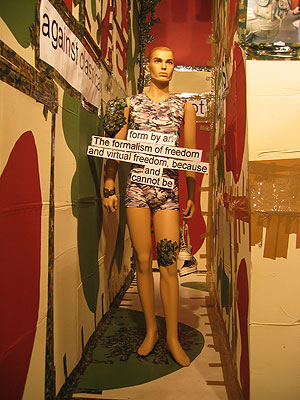Thomas Hirschhorn
dal 9/3/2006 al 12/5/2006
Segnalato da
9/3/2006
Thomas Hirschhorn
CCA Wattis Institute for Contemporary Arts, San Francisco
This multilayered project explores the current world situation, permeated by military conflicts and violence, through the metaphor of camouflage, which has been adapted from battlefield uniform to street fashion statement. For this show he exaggerates traditional display elements from museums, combining abundant signage, illustrations, interpretive material, mannequins, vitrines and artworks.

Utopia, Utopia = One World, One War, One Army, One Dress
The CCA Wattis Institute for Contemporary Arts presents "Utopia, Utopia = One World, One War, One Army, One Dress," an exhibition of new work by Swiss-born, Paris-based artist Thomas Hirschhorn. This multilayered project explores the current world situation, permeated by military conflicts and violence, through the metaphor of camouflage, which has been adapted from battlefield uniform to street fashion statement. Coorganized with the Institute of Contemporary Art (ICA), Boston, "Utopia, Utopia" is a dynamic environment comprising sculptural works, wall graphics, film and video footage, vitrines and maquettes. The exhibition is on view March 10-May 13, 2006, in the CCA Wattis Institute's Logan Galleries on the San Francisco campus of California College of the Arts. The exhibition is free and open to the public. (The ICA presentation of the exhibition opened September 21 and is on view through January 16, 2006.)
The conceptual leaping-off point for "Utopia, Utopia" is the prevalence of camouflage in contemporary culture and politics—as a style of dress on the streets of SoHo and as an emblem of battle in the current conflicts in Afghanistan and Iraq. On the level of fashion, camouflage signifies toughness—an affectation that draws attention to the self. In contrast, soldiers wear camouflage to disappear, to better function within the group or army by removing themselves from view. Hirschhorn sees this as an allegory for the dystopia of current events, asking what it means when a costume of war becomes a look or a style. The artist takes this fashion trend to the extreme, creating a utopian world of equality whereby military camouflage becomes the clothing of everybody on earth.
"Hirschhorn's work, like the best of philosophy, helps us to grapple with and more deeply understand the world we live in," says Ralph Rugoff, director of the CCA Wattis Institute. "Challenging yet also accessible, 'Utopia, Utopia' engages the dark side of our society while reaffirming art's power to illuminate the condition of contemporary culture."
Hirschhorn is known for energetic installations that reference philosophy, politics and pop culture. His multifaceted constructions often combine ephemeral materials, such as aluminum foil, cardboard, plastic, plywood or pages torn from magazines, with a wide array of cultural references and theoretical texts. For "Utopia, Utopia," Hirschhorn exaggerates traditional display elements from museums, combining abundant signage, illustrations, interpretive material, mannequins, vitrines and artworks.
"With its sprawling presentation and charged political content, 'Utopia, Utopia' seeks to engage visitors on many levels, literally and figuratively surrounding them with ideas," says Nicholas Baume, ICA chief curator. "Its dramatic presentation and aggressive design represents a collision of aesthetics and politics."
Philosopher Marcus Steinweg provides the major textual component of the installation design. A publication designed in collaboration with the artist documents the exhibition and includes writings by Hirschhorn and art historian Pamela M. Lee about camouflage, subjectivity and war. The publication is free to visitors.
Thomas Hirschhorn was born in 1957 in Bern, Switzerland, and lives and works in Aubervilliers, France. After studying graphic design at the Schule fr Gestaltung in Zurich, Hirschhorn moved to France and joined Grapus, a Parisian collective of communist graphic designers. Since abandoning design for visual art in the mid-1980s, he has exhibited internationally, with major works included in the 1st Biennial of Johannesburg (1995), the Venice Biennale (1999) and Documenta XI (2002).
Established in 1998, the CCA Wattis Institute serves as a forum for the presentation and discussion of leading-edge local, national and international contemporary culture. Through exhibitions, the Capp Street Project residency program, lectures, symposia, performances and publications in the fields of art, architecture and design, the CCA Wattis Institute fosters interaction among the students and faculty of California College of the Arts; art, architecture and design professionals; and the general public.
Opening: 10 March
CCA Wattis
1111 Eighth Street (California College of the Art) - San Francisco



